Essential Safety Gear in Boxing: Protecting Fighters Inside the Ring

Boxing is a sport that demands both physical prowess and proper protection. From head to toe, boxers rely on specialized safety gear to mitigate risks and ensure their safety during training and competition. In this blog, we explore the various types of safety gear essential for every boxer, highlighting their importance and functionality.
1. Boxing Gloves: Protecting Hands and Opponents
Boxing gloves are perhaps the most recognizable piece of safety gear in the sport. They serve multiple purposes beyond just protecting the fighter’s hands.
Key Features and Benefits:
– Padding: Thick padding around the knuckles and back of the hand absorbs impact, reducing the risk of hand injuries.
– Protection for Opponents: Gloves also protect the opponent from severe injuries by cushioning the impact of punches.
– Regulation Compliance: Gloves are regulated by weight (in ounces), with heavier gloves typically used for sparring to minimize impact and lighter gloves for competitive bouts.
2. Hand Wraps: Supporting Wrist Stability
Hand wraps are essential for boxers to stabilize their wrists and protect the small bones and joints in their hands.
Functionality:
– Compression and Support: Hand wraps compress the bones and tissues in the hand, reducing the risk of fractures and sprains.
– Wrist Stability: They provide additional support to the wrist, preventing hyperextension during punches.
– Hygiene: Hand wraps also help absorb sweat, keeping the gloves dry and reducing the risk of slipping.
3. Headgear: Guarding Against Head Injuries
While controversial in professional bouts due to varying opinions on its effectiveness, headgear remains crucial for amateur and training purposes.
Importance:
– Impact Absorption: Headgear helps absorb and distribute impact forces, reducing the risk of cuts, bruises, and superficial head injuries.
– Preventing Concussions: While not foolproof, headgear can lessen the severity of impacts that might otherwise cause concussions.
– Regulatory Use: Many amateur and youth boxing associations mandate the use of headgear to enhance safety during sparring and training sessions.
4. Mouthguard: Protecting Teeth and Jaw
A mouthguard is a vital piece of equipment that protects the teeth, jaw, and head from impact during boxing.
Benefits:
– Shock Absorption: Mouthguards absorb and distribute impact forces, reducing the risk of dental fractures, tooth loss, and jaw injuries.
– Concussion Prevention: Properly fitted mouthguards can help reduce the incidence and severity of concussions by cushioning blows to the jaw.
– Custom Fit: Custom-made mouthguards provide better protection and comfort compared to standard boil-and-bite models.
5. Groin Protector: Ensuring Lower Body Safety
A groin protector is essential for male boxers to protect the sensitive groin area from accidental strikes.
Functionality:
– Impact Resistance: Groin protectors shield against low blows and accidental impacts, minimizing pain and potential injuries.
– Regulation Requirement: They are mandatory in most competitive boxing events and sparring sessions to ensure the safety and well-being of fighters.
6. Body Protectors: Safeguarding the Torso
Body protectors are used primarily in training sessions, providing additional cushioning and protection to the torso.
Usage:
– Training Benefits: Body protectors allow boxers to practice body shots and combinations with reduced risk of injury to both the attacker and the defender.
– Padding and Comfort: They offer padding against impact, reducing bruises and contusions during intense training drills.
7. Footwear: Supporting Movement and Stability
While not traditionally considered safety gear, proper footwear plays a crucial role in a boxer’s stability and injury prevention.
Footwear Features:
– Ankle Support: Boxing shoes provide ankle support, enhancing stability during footwork and lateral movements.
– Grip and Traction: They offer grip and traction on the canvas, preventing slips and falls during quick directional changes.
– Lightweight Construction: Lightweight shoes allow for swift movements and agility, essential for competitive bouts.
Conclusion
Each piece of safety gear in boxing serves a specific purpose in protecting fighters from various injuries and ensuring a safe training and competition environment. From gloves and hand wraps to headgear and mouthguards, these essential tools not only mitigate risks but also allow boxers to focus on honing their skills and technique. By prioritizing safety and adhering to proper equipment standards, the sport can continue to thrive while safeguarding the well-being of its participants.
Stay tuned to Boxing Safety Gear for more insights, tips, and updates on the latest advancements in safety equipment for boxing. Protect yourself, protect your opponent, and enjoy the sport responsibly.
